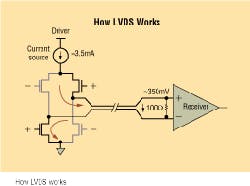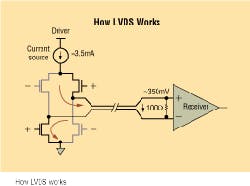LVDS data transmission catches on in defense and satellite applications
LVDS data transmission catches on in defense and satellite applications
By John McHale
SANTA CLARA, Calif. — Engineers at National Semiconductor in Santa Clara, Calif., and UTMC Microelectronics Systems in Colorado Springs, Colo., see military designers turning toward low-voltage differential signaling (LVDS) for high-performance data transmission applications.
LVDS runs on low power at a high signal rate. Its low electromagnetic interference (EMI) and low noise making it attractive for defense and satellite applications — particularly for radar — says Russ Thelig, strategic marketing manager or enhanced solutions at National. LVDS is a way to solve high-speed I/O interface problems, he adds.
National`s LVDS products are designed into a missile-guidance system and a board-to-board application on a communication satellite, Thelig says.
"Customers are demanding higher serial data rates for intra-satellite communication," says Anthony Jordan, standard product line manager at UTMC. "Applications such as communications payload, sensor, and instrument systems will benefit from the higher serial data rates, low power, and low noise of the LVDS family."
Jordan and his colleagues plan to use LVDS for integrated serial data bus products.
LVDS is also inexpensive in cost per megabyte of data transfer, Thelig adds. National`s LVDS products operate at 155 megabytes per second, and company engineers are working increasing it to 400 megabytes per second, Thelig claims.
SEAKR engineers use LVDS in their Data Transfer System (DTS), a device for collecting recorded data from an aircraft (see story page 17). Going with LVDS was a performance decision, he says.
LVDS pumps the data out at "a sustained rate of 100 megabytes per second and can complete a full download of 48 gigabytes of memory in 10 minutes," claims Randolph Twogood, director of military electronics at SEAKR Engineering in Englewood, Colo.
Experts at Spectrum Signal Processing in Burnaby, British Columbia, are using LVDS cells from Atmel in Colorado Springs, Colo., for the physical communication connection of their Solano integrated circuit (IC), says Dave Hobbs, chief technology officer and vice president of engineering at Spectrum.
Spectrum engineers chose LVDS for its noise immunity, low-voltage swing, and its impedance-controlled low-voltage signals — as fast as 400 megabits per second on each differential pair, Hobbs says.
The Solano IC enables designers to network Spectrum boards and mezzanine cards together. This expansion support allows connections to proprietary I/O devices or to standard communications protocols such as Asynchronous Transfer Mode or Fibre Channel, for long-distance communications.
LVDS is spelled out in the ANSI/TIA/EIA-644-1995 Electrical characteristics standard "Electrical Characteristics of low-voltage Differential Signaling (LVDS) Interface Circuits." It defines driver output characteristic and receiver input characteristics. It includes guidelines on bus configuration, cables, and termination, National officials say. It does not define protocol, connectors, and bus structure.
LVDS does not define a maximum data rate within the standard. Data rate is basically dependent on the application — required signal quality, National officials say. LVDS will address data rates ranging from 100 megabytes per second to more than 1 gigabyte per second.
National engineers use LVDS in simple line driver and receiver physical layer devices as well as in complex interface communication chipsets. The Channel Link chipsets multiplex and demultiplex slow TTL signal lines to provide a narrow, high-speed, low-power LVDS interface, National officials say.
These chipsets help save on cable and connector costs, and reduce the physical space necessary for the connector, Thelig says. National also offers Bus LVDS products for multipoint cable or backplane applications. Bus LVDS provides more drive current than standard LVDS to handle double terminations in multipoint applications.
National`s Bus LVDS products come in two categories: line drivers and receivers, and serializer/deserializer. Bus LVDS eliminates the need for a special termination pull-up rail and the need for active termination devices. It uses common power supply rails (3.3 volts or 5 volts), employs a simple termination scheme, minimizes power dissipation in the interface devices, generates little noise, supports live insertion of cards, and drives heavily loaded multi-point busses at 100 megabytes per second, National officials claim.
UTMC`s LVDS commercial RadHard CMOS technology products operate from 5-volt power, are radiation hardened to 300 kilorads, and deliver data at 155 megabytes per second.
UTMC offers two LVDS products — the UT54LVDS031 Quad Driver and UT54LVDS032 Quad Receiver. Both low-cost devices are for commercial and military satellite applications, Jordan says.
Courtesy of National Semiconductor

